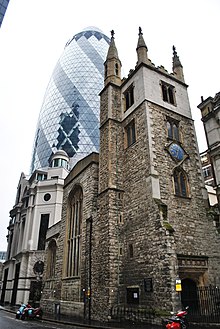St Andrew Undershaft
| St Andrew Undershaft | |
|---|---|
 St Andrew Undershaft in 2013 | |
 | |
| Location | London,EC3 |
| Country | England |
| Denomination | Church of England |
| Churchmanship | Conservative Evangelical |
| History | |
| Founded | 1147 |
| Architecture | |
| Heritage designation | Grade Ilisted building |
| Style | Perpendicular style |
| Years built | 1532 |
| Administration | |
| Diocese | London |
St Andrew Undershaftis aChurch of Englandchurchin theCity of London,the historic nucleus and modern financial centre of London. It is located onSt Mary Axe,within theAldgateward, and is a rare example of a City church that survived both theGreat Fire of Londonandthe Blitz.[1]
The present building was constructed in 1532 but a church has existed on the site since the 12th century. Today, St Andrew Undershaft is administered from the nearbySt Helen's Bishopsgatechurch.
History
[edit]
The first church on the site, which today is bordered bySt Mary AxeandLeadenhall Street,was built inmedieval times,being recorded in 1147.[2]It was rebuilt in the 14th century and again in 1532;[3]this third incarnation of the building survives today. It is in thePerpendicular style[4]with its entrance located at the base of its off-centre tower. The interior is divided into six bays, with many of the original fittings that survived theVictorianrenovation. Formerly, St Andrew Undershaft had one of London's few surviving large stained-glass windows, installed in the 17th century, but this was destroyed in theBaltic Exchange bombingin 1992.

The church's curious name derives from the shaft of themaypole[5]that was traditionally set up each year opposite the church.[6]The custom continued each spring until 1517, when student riots put an end to it, but the maypole itself survived until 1547 when it was seized by a mob and destroyed as a "pagan idol".[7]According toJohn Stow,the chronicler who is buried here, they had it "raised from the hooks whereon it had rested for two-and-thirty years, sawn in pieces and burnt."[8]
St Andrew Undershaft is now administered from the nearby church ofSt Helen's Bishopsgate.St Andrew Undershaft was designated a Grade Ilisted buildingon 4 January 1950.[9]
The tower holds a peal of six bells in the key of G, with the tenor being cast in 1597 by Robert Mot. These are now hung dead (they can only be rung stationary) inside the tower.[10]
Organ
[edit]
Theorganwas installed in 1696 byRenatus Harris.A swell was added in 1750 by John Byfield. There have been other restorations and enhancements byGeorge Pike Englandin 1810–11 and 1826. Further work was carried out by William Hill, Speechly and J. W. Walker & Sons, andRushworth and Dreaper.A specification of the organ can be found on the National Pipe Organ Register[11]
The organ is of such historic significance that it has been awarded a Grade I historic organ certificate by theBritish Institute of Organ Studies.
Organists
[edit]- William Goodgroome, 1696
- Philip Hart,1697–1749
- John Worgan,1749–1790
- Mary Allen, 1790–1836
- Richard Limpus,1847
- William Rea, 1847–1858
- Elizabeth Stirling,1858–1880
- C. F. Frye, 1880–1886
- W. M. Wait, 1887–1891
- Herbert George Preston, 1891–1912[12]
- William A. S. Ballard, 1913–1921[13]
Notable people associated with the church
[edit]- Sir Thomas Offley,Lord Mayor of London 1563–64, was buried in 1582. The monument to Sir Thomas and his wife Joan (died 1578) survives in St Andrew Undershaft. Joan was a granddaughter ofSir Stephen Jennings,Lord Mayor, who funded the rebuilding of the church.[14]
- John Stow,author of theSurvey of London:buried in 1605. The quill pen held in the hand of his alabaster monument is renewed periodically by, alternately, the Lord Mayor of London and the Master of theWorshipful Company of Merchant Taylors,at a memorial service organised by theLondon and Middlesex Archaeological Society.
- Hugh Hamersley,Lord Mayor of London in 1627, whose memorial is in St Andrew Undershaft.
- Hans Holbein the Younger,a former parishioner of St Andrew Undershaft was possibly buried in the church.
- Frederick George Blomfield, rector of St Andrew Undershaft (1853–1879), son ofCharles James Blomfield(Bishop of London) and father ofDorothy Gurney(poet and hymn writer).
- John Lawrence Toole,a comedian who was born and christened in St Andrew Undershaft.
- Fabian Stedmanthe father of church bellringing was buried in St Andrew Undershaft.
See also
[edit]Notes
[edit]- ^The Visitors Guide to the City of London ChurchesTucker, T: London, Friends of the City Churches, 2006ISBN0-9553945-0-3
- ^The London EncyclopaediaHibbert, C.; Weinreb, D.; Keay, J.: London, Pan Macmillan, 1983 (rev 1993, 2008)ISBN978-1-4050-4924-5
- ^London:the City ChurchesPevsner, N./Bradley, S.: New Haven, Yale, 1998ISBN0-300-09655-0
- ^The City of London ChurchesBetjeman, J.Andover, Pikin, 1967ISBN0-85372-112-2
- ^The City ChurchesTabor, M. p. 27:London; The Swarthmore Press Ltd; 1917
- ^Cobb, G.London city churches:London, B T Batsford Ltd., 1977
- ^"The City of London Churches: monuments of another age" Quantrill, E; Quantrill, M p36: London; Quartet; 1975
- ^A Pictorial and Descriptive Guide to London.Ward Lock & Co. 1928. p. 124.Guide to London.
- ^Historic England."Church of St Andrew Undershaft (1079155)".National Heritage List for England.Retrieved23 January2009.
- ^"St Andrew Undershaft".london.lovesguide.Archived fromthe originalon 18 February 2003.
- ^"NPOR [N17628]".National Pipe Organ Register.British Institute of Organ Studies.Retrieved7 October2021.
- ^Dictionary of Organs and Organists,First Edition, Frederick W. Thornsby, 1912
- ^Dictionary of Organs and Organists,Second Edition. G. A. Mate, 1921
- ^W. J. Thoms,A Survey of London written in the year 1598, by John Stow(Chatto & Windus, London 1876),p. 194.
